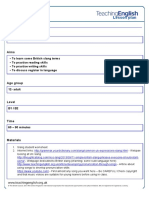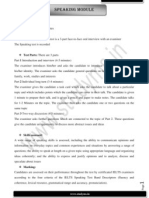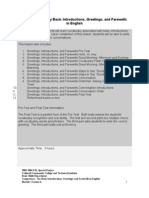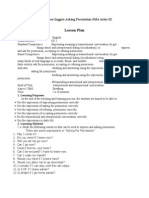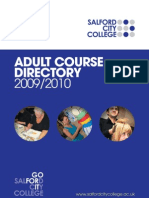Colloquial and Slangs
Colloquial and Slangs
Uploaded by
api-242598361Copyright:
Available Formats
Colloquial and Slangs
Colloquial and Slangs
Uploaded by
api-242598361Original Title
Copyright
Available Formats
Share this document
Did you find this document useful?
Is this content inappropriate?
Copyright:
Available Formats
Colloquial and Slangs
Colloquial and Slangs
Uploaded by
api-242598361Copyright:
Available Formats
British and American English and Slangs Lesson Plan
Name: Asmaa Taha Time: 6:00- 8:00 pm Date: 5/11/2013 Level: Low Intermediate
Grammar/Lx Focus: Pragmatics &Semantics & Phonology
Context: ESL-International Partners/Spouses of Faculty
Learning Aims: Main aim By the end of the lesson, students will be able to identify some of the differences between American and British English. They will also be able to know and use some American slangs in informal conversations. Subsidiary aim: By the end of the lesson, students will be able to pronounce target colloquial words/phrases with the correct intonation and stress. Students will also be able to use intonation and stress appropriately.
Anticipated problems: Pronunciation problems as intonation and stress of colloquial words/phrases
Students might not know some new vocabulary that will be presented them in video context. Students might need to watch the video more than two times. http://www.youtube.com/watch?v=75KrlGjCink
Materials: Stage aim 1) Lesson Objectives 2) Warm Up (Semantics) Stage/Procedure The teacher will introduce the lesson objectives to the students. The teacher will warm the students up by asking the students to discuss the meaning of the two idioms/slang provided in the pictures. They will work in pairs then the teacher will check with them. The main idea of this activity is to activate the students schemata about colloquial words/phrases. Students will work in groups of 4 to guess the meaning of the colloquial words/phrases. The teacher will monitor and help if needed. When they finish, the teacher will give class feedback. The teacher will focus on meaning of these colloquial words/phrases. The teacher will ask the students practice saying the colloquial words/phrases focusing on intonation and stress. They will practice with the teacher and any correction will be given if needed. The teacher will ask the students to write 6 sentences about their lives to practice using the target vocabulary. The teacher provides some examples for them. When they are done, students will take turn saying their sentences to their classmates. Then they will ask some follow up questions about their sentences. Students will have a short break. Interaction patterns Teacher- Student Student- Student Teacher- Student Student- Student Teacher- Student 10 minutes Timing 5 minutes
10 minutes
3) Presenting colloquial words/phrases (Semantics) 4) pronunciation of colloquial words/phrases (Phonology) 5) practice using colloquial words/phrases (writing) (speaking) Exercises 4 &5 6) Break
Student- Student Teacher- Student Student- Student Teacher- Student
10 minutes
10 minutes
10 minutes
7) Discussion questions (lead in activity)
The students will discuss the questions about British English and American English in pairs. The teacher will check with students when they finish and will give some personalized example about him/her.
Student- Student Teacher- Student
5 minutes
8) Presenting new vocabulary British English and American English
9) Practice new vocabulary Exercise 8 & 9
10) American slang (skim listening ) 11) American slang (listening for details ) & (Semantics) 12) discussion questions (Pragmatics) 1) Assessment & wrap-up
Students will work in groups of 3 to provide the equivalents words used in American English to the provided words used in British English. The main purpose behind this activity is to raise students awareness of the difference between American and British English. The teacher will monitor and give help and support if needed. The teacher will check with the students when they finish. The teacher will elicit/provide some examples of the target vocabulary in a context. The students will work in groups to write 5 sentences using words used in American English. The teacher will monitor and give help and support if needed. The teacher will check with the students when they finish. Then students will work in groups of 3 to think about other differences between American English and British English either. The teacher will check with the class and then the teacher will highlight that there are other differences in meaning, vocabulary, pronunciation and writing. The teacher will provide examples Students will watch a video in which there are two American guys teaching a British guy some American slang words. They will try to recognize any of these slang words used in the South of US. Students will watch the video again and fill in the gaps with the American slang words matching them with their British equivalent words. When they finish the activity and when they check their answers, the teacher will work on the meaning of these slang words with the class. The students will discuss the questions about the use of slang language in pairs. The teacher will check with students when they finish and will give some examples. The teacher will ask students to provide some words/phrases they learnt from the lesson. The main purpose of this activity is to check and assess students understanding of the lesson. It is a nice wrap up to let the students think, reflect.
Student- Student Student- Teacher
20 minutes
Teacher - Student
10 minutes
Student- Teacher
Student- Student Student- Teacher Student- Student Student- Teacher Student- Student Teacher - Student Student- Student Student- Teacher
10 minutes
10 minutes
minutes
5 minutes
A. 1. 2. 3.
Directions: Discuss these questions in pairs: Do you use your phone a lot? Who are the three people you call or text the most? Do you usually need to speak English on the phone? How often do you speak English on the phone? B. Directions: Work in group of two to fill in the gaps with the suitable word. called meeting off on break message
1) 2) 3) 4) 5) 6)
I am sorry but he is in his lunch . Can I take a .. for him? Would you like me to tell him that you I am sorry, hes in a Would you like to a message? Hold., please. Ill put you through.
C. Directions: With a partner, match sentences 1-6 to the following headings a-c. a) Asking someone to wait b) Saying someone isnt available c) Offering to take a message D. Directions: With a partner, practice saying the sentences 1-6 paying attention to the intonation. E. Directions: With a partner, think about the following questions.
1) What is the first thing you say when we call someone? 2) How do we start a phone conversation? 3) What is the last thing you say before ending a phone conversation? 4) How do we end a phone conversation? 5) What do you say if you want to leave a message to someone on the phone? 6) What do you say if you want to speak to someone on the phone?
F. Directions: Match the headings to the sentences from the phone conversations. saying where people can contact you leaving a message asking to speaking to someone
1) Can I speak to David, please? Is David there, please? Could I speak to Peter, please? 2) .. Could you ask him/her to call me tomorrow? Can you ask him/her to call me back? Just tell him/her David called. 3) .. He/she can call me at the office. He/she can call me on my cell. He/she can call me at home this evening. G. Directions: With a partner, practice saying a-c in the exercise F paying attention to the intonation. H. Directions: Listen to the phone conversation and answer the following questions. 1) Why didnt peter call David at first? 2) Why did David call Peter? 3) What will they do on Saturday? I. Directions: Now practice the conversation with a partner paying attention to the intonation.
David: Hello, David Osborne. Peter: Hello David. Its Peter. I got your message. David: Finally, where are you? I called you twice. Peter: Im so sorry. It was such a busy day and I didnt have a chance to call you back. David: No worries, listen! I am going to the golf course, would you like to come with me?
Peter: Sure. Id love too and I am going to beat you this time. Just wait! David: Well, well see! See you on Saturday then at noon as usual. Peter: yeah. Ill see you then. Bye. David: alright. Bye
J. Work in pairs to write a phone conversation between A and B. A is calling a friend at work and B is the receptionist at the friends office. Use sentenc es from exercises B and F.
K. Now practice the conversation in pairs and share it with your class. Which one is the most interesting and why?
You might also like
- LessonplanwithtechnologyDocument15 pagesLessonplanwithtechnologyapi-255292644No ratings yet
- Linked Sounds RulesDocument22 pagesLinked Sounds RulesDominick Monteiro BritoNo ratings yet
- Lesson 1 & Aims Content Material Homework: A Chunk? What Kinds of Words Carry The Main Stress?)Document9 pagesLesson 1 & Aims Content Material Homework: A Chunk? What Kinds of Words Carry The Main Stress?)Robert McCaulNo ratings yet
- Classroom Activity 4 - Asking Simple Questions About Everyday LifeDocument4 pagesClassroom Activity 4 - Asking Simple Questions About Everyday Lifem3997859No ratings yet
- The Basics of English For The TOEIC (R) L&R TEST Teacher's ManualDocument61 pagesThe Basics of English For The TOEIC (R) L&R TEST Teacher's ManualChayanitNo ratings yet
- 10-12 EnglishDocument5 pages10-12 Englishapi-294708096No ratings yet
- Slang Lesson PlanDocument4 pagesSlang Lesson PlanPaola CorsiNo ratings yet
- Unit Plan1Document6 pagesUnit Plan1api-252106308No ratings yet
- Sample Lesson Plans - ActivityDocument4 pagesSample Lesson Plans - ActivityMarkee ChoiNo ratings yet
- CELTA PRE 3Document12 pagesCELTA PRE 38q8vydptytNo ratings yet
- Direct File Topic DownloadDocument61 pagesDirect File Topic DownloadPablo S. DarioNo ratings yet
- French 3 LessonsDocument10 pagesFrench 3 Lessonsapi-242011178No ratings yet
- BEC Teacher's GuideDocument43 pagesBEC Teacher's GuideNguyen_Manh_QuynhNo ratings yet
- Educ 457 TPADocument6 pagesEduc 457 TPAashleyb12No ratings yet
- IELTS-Academic Speaking ModuleDocument21 pagesIELTS-Academic Speaking Moduleapi-141009395No ratings yet
- ISE I - Independent Listening Task 2 - CA1 (Learning A Foreign Language) PDFDocument14 pagesISE I - Independent Listening Task 2 - CA1 (Learning A Foreign Language) PDFLizbeth Gil100% (1)
- Lesson Plan Greetings Intros FarewellsDocument7 pagesLesson Plan Greetings Intros FarewellsRazman SuhailinNo ratings yet
- EFL Lesson Plan 4 IntermediateDocument3 pagesEFL Lesson Plan 4 IntermediateVeronica HerreraNo ratings yet
- Writing B1 Unit 2Document4 pagesWriting B1 Unit 2eddydasilvaNo ratings yet
- Teaching Pronunciation: Special Problems Encountered by A Foreign Learner of EnglishDocument4 pagesTeaching Pronunciation: Special Problems Encountered by A Foreign Learner of EnglishImeneNo ratings yet
- Apuntes Preparacion de IELTSDocument29 pagesApuntes Preparacion de IELTSasdasdasdNo ratings yet
- Cambridge English: Advanced Speaking (From 2015) Sample Test With Examiner's CommentsDocument11 pagesCambridge English: Advanced Speaking (From 2015) Sample Test With Examiner's CommentsLili Lili100% (1)
- Speaking Time 3 TGDocument6 pagesSpeaking Time 3 TGValentinaNo ratings yet
- Speaking Lesson Plan 1Document9 pagesSpeaking Lesson Plan 1Adity ChamuahNo ratings yet
- Uploud Journal GrammarDocument9 pagesUploud Journal Grammarsalsabilatazkia143No ratings yet
- CELTA Pre-Interview Task - FekyDocument5 pagesCELTA Pre-Interview Task - FekyFeky BirdNo ratings yet
- Teachers Book Key To Bachillerato 1Document15 pagesTeachers Book Key To Bachillerato 1Jose Miguel Perez32% (44)
- Assessment Lesson 5 FashionDocument2 pagesAssessment Lesson 5 Fashionapi-434051929No ratings yet
- Grade 3 e Phonics Lesson Plan LaDocument6 pagesGrade 3 e Phonics Lesson Plan Laapi-264279988100% (1)
- Lesson PlanDocument18 pagesLesson PlanAgus HandokoNo ratings yet
- CELTA PRE 2Document10 pagesCELTA PRE 28q8vydptytNo ratings yet
- British School of Ulaanbaatar: Methodology and Pedagogy Training Application FormDocument9 pagesBritish School of Ulaanbaatar: Methodology and Pedagogy Training Application FormАйсаулеNo ratings yet
- How To Pass Delta LabsDocument14 pagesHow To Pass Delta LabsWagner Felix67% (3)
- A Questionnaire For TeachersDocument3 pagesA Questionnaire For TeachersNicole Wing Teng Mak33% (3)
- Lesson Plan Form MontessoriDocument13 pagesLesson Plan Form MontessoriCarlos Andres LaverdeNo ratings yet
- Lesson Plan Tema Telling TimesDocument2 pagesLesson Plan Tema Telling TimesMuhammad FauziNo ratings yet
- Background of Audio-Lingual MethodDocument4 pagesBackground of Audio-Lingual Methodindra tamaraNo ratings yet
- Vocab Spot CheckDocument9 pagesVocab Spot CheckMr. Yogesh RamaniNo ratings yet
- Reading Improvement Seminar-WorkshopDocument14 pagesReading Improvement Seminar-WorkshopPearl AsuncionNo ratings yet
- Icelt TPDocument18 pagesIcelt TPliesilNo ratings yet
- g2 Computer Sciences Ucb Ongoing VersionDocument92 pagesg2 Computer Sciences Ucb Ongoing Versiongloirelemba22No ratings yet
- Mini Lesson Plan 1Document3 pagesMini Lesson Plan 1api-260889954No ratings yet
- Lesson Plan Form MontessoriDocument13 pagesLesson Plan Form MontessoriCarlos Andres Laverde100% (2)
- Pre Course TaskDocument14 pagesPre Course TaskKaiss SouffNo ratings yet
- Case 1 Lesson PlanDocument5 pagesCase 1 Lesson Planapi-248123584No ratings yet
- Word Study Lesson PlanDocument2 pagesWord Study Lesson Planapi-240991456No ratings yet
- The Gingerbread Man EFL Lesson PlanDocument5 pagesThe Gingerbread Man EFL Lesson PlanSherlleNo ratings yet
- Unit3 Mod3Document41 pagesUnit3 Mod3Ameni Hlioui Chokri100% (1)
- 1.1.2the Direct Method GoodDocument6 pages1.1.2the Direct Method GoodKevin RodriguezNo ratings yet
- TP Points Speakout A1Document11 pagesTP Points Speakout A1Lana IDNo ratings yet
- Job Interview Objectiveshow To Get To Guate Celsa Test Communication SkillsDocument20 pagesJob Interview Objectiveshow To Get To Guate Celsa Test Communication SkillsDianaCornejoNo ratings yet
- Lesson Plan On VerbalsDocument4 pagesLesson Plan On VerbalsAlain Delon Lim Serino93% (44)
- câu hỏiDocument4 pagescâu hỏiTiên LêNo ratings yet
- Lesson Plans and Activities for Teachers and Tutors of ESL for AdultsFrom EverandLesson Plans and Activities for Teachers and Tutors of ESL for AdultsRating: 4 out of 5 stars4/5 (15)
- How to Reach the 9.0 in IELTS Academic SpeakingFrom EverandHow to Reach the 9.0 in IELTS Academic SpeakingRating: 4 out of 5 stars4/5 (9)
- Icebreakers. Perfect start for your language class: Teach - Love - Inspire. bel activity + games bookletsFrom EverandIcebreakers. Perfect start for your language class: Teach - Love - Inspire. bel activity + games bookletsNo ratings yet
- Fifty Ways to Practice Speaking: Tips for ESL/EFL StudentsFrom EverandFifty Ways to Practice Speaking: Tips for ESL/EFL StudentsRating: 4.5 out of 5 stars4.5/5 (7)
- J201 - Syllabus - Spring2015Document16 pagesJ201 - Syllabus - Spring2015Gus NavaNo ratings yet
- Top Ten Tips For Teachers Preparing Students For The Academic Version of IeltsDocument20 pagesTop Ten Tips For Teachers Preparing Students For The Academic Version of Ieltspatru177No ratings yet
- G7 DLL ART-4th QuarterDocument3 pagesG7 DLL ART-4th QuarterCris Eliel Platon100% (1)
- Advertisement For Website Scholarship 2021-22Document4 pagesAdvertisement For Website Scholarship 2021-22Mirza Riyasat AliNo ratings yet
- Adult Course Directory: WWW - Salfordcitycollege.ac - UkDocument12 pagesAdult Course Directory: WWW - Salfordcitycollege.ac - Ukmateimatei04No ratings yet
- 1st SEM ResultDocument298 pages1st SEM ResultMafiaNo ratings yet
- DSM 5 Specific Learning Disorder Fact SheetDocument2 pagesDSM 5 Specific Learning Disorder Fact SheetAnonymous Pj6Odj0% (1)
- Probyto: Registration Form Course Coordinators From AcademyDocument2 pagesProbyto: Registration Form Course Coordinators From Academythunder775No ratings yet
- Guidelines On The Online Dormitory Application For AY 2018-2019Document5 pagesGuidelines On The Online Dormitory Application For AY 2018-2019Emman Joshua BustoNo ratings yet
- KVPY2011 (Stage I) ResultDocument2 pagesKVPY2011 (Stage I) ResultAnshuman DashNo ratings yet
- 26.10six Thinking Hats - Efficient Decision Making TechniqueDocument51 pages26.10six Thinking Hats - Efficient Decision Making TechniqueRamesh Chandra DasNo ratings yet
- Assignment Violence in SportDocument5 pagesAssignment Violence in SportAkeem ShittuNo ratings yet
- CBE 3310 Process Dynamics and Control PDFDocument8 pagesCBE 3310 Process Dynamics and Control PDFHeri RustamajiNo ratings yet
- 02 Performance Task 1 Batch SecurityDocument2 pages02 Performance Task 1 Batch Securitynerojodel7No ratings yet
- Synthesis PaperDocument5 pagesSynthesis Papermay rose doricoNo ratings yet
- CBME Implementation Feedback QuestionnaireDocument3 pagesCBME Implementation Feedback QuestionnairedeangimsrNo ratings yet
- Oysterponds U.F.S.D. in Orient 23405 MAIN ROAD ORIENT NY 11957Document6 pagesOysterponds U.F.S.D. in Orient 23405 MAIN ROAD ORIENT NY 11957TimesreviewNo ratings yet
- 2015 PSPM Kedah BI2 W AnsDocument22 pages2015 PSPM Kedah BI2 W Ansjee2kk67% (6)
- First Peoples A Guide For Newcomers PDFDocument91 pagesFirst Peoples A Guide For Newcomers PDFlibredescargaNo ratings yet
- Fezzan Nigeria Limited: This Is A Sample Form. Please Visit To Apply For The ProgrammeDocument5 pagesFezzan Nigeria Limited: This Is A Sample Form. Please Visit To Apply For The ProgrammeNakky NakkizyNo ratings yet
- Syallabus of PGDC PDFDocument61 pagesSyallabus of PGDC PDFSaurabh KumarNo ratings yet
- Adelle Grace Montessori School Incorporated: A. Content Standards B. Performance Standard C. Learning CompetenciesDocument2 pagesAdelle Grace Montessori School Incorporated: A. Content Standards B. Performance Standard C. Learning CompetenciesCherish April BaulNo ratings yet
- Urdaneta City University: Project ProposalDocument3 pagesUrdaneta City University: Project ProposalNicole Danielle MallariNo ratings yet
- Cognitive CoachingDocument5 pagesCognitive CoachingBhooshan Parikh100% (7)
- Multiple Choices Direction: Choose The Letter of The Correct Answer and Write It On The Blank Provided at TheDocument3 pagesMultiple Choices Direction: Choose The Letter of The Correct Answer and Write It On The Blank Provided at TheReonel GalayNo ratings yet
- Revised Critical ReasoningDocument23 pagesRevised Critical Reasoningविkraम वrमाNo ratings yet
- TES Sharing Agreement. AY 2020 2021 1Document2 pagesTES Sharing Agreement. AY 2020 2021 1Chesca UrietaNo ratings yet
- Dost Soep SyllabusDocument3 pagesDost Soep SyllabusJona AddatuNo ratings yet
- Peer Review WorksheetDocument2 pagesPeer Review Worksheetapi-372806629No ratings yet
- Let RVWRDocument100 pagesLet RVWRCatherine PascualNo ratings yet







